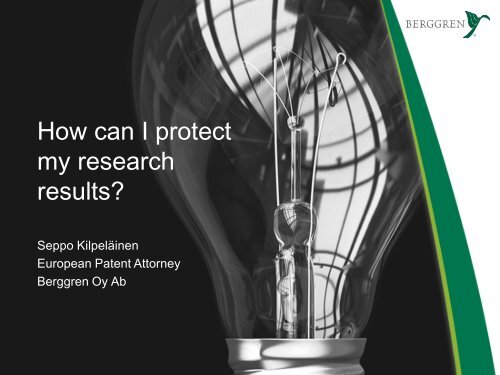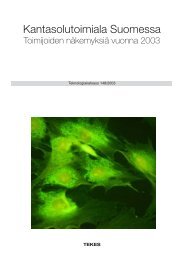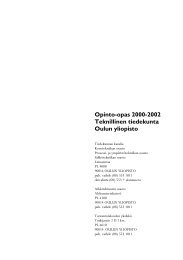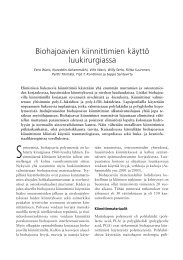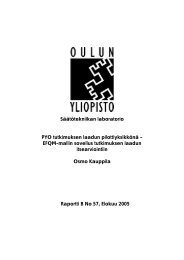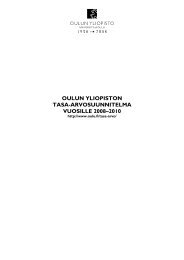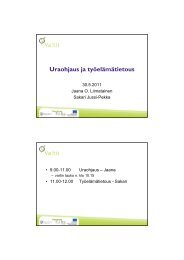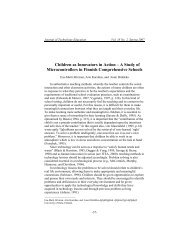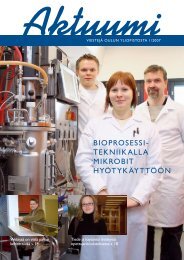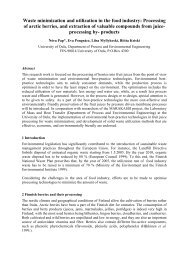How can I protect my research results? - Oulu
How can I protect my research results? - Oulu
How can I protect my research results? - Oulu
Create successful ePaper yourself
Turn your PDF publications into a flip-book with our unique Google optimized e-Paper software.
<strong>How</strong> <strong>can</strong> I <strong>protect</strong><br />
<strong>my</strong> <strong>research</strong><br />
<strong>results</strong>?<br />
Seppo Kilpeläinen<br />
European Patent Attorney<br />
Berggren Oy Ab
Common academic prejudices<br />
about patenting<br />
• ”patenting delays publishing/graduating/everything”<br />
• ”science <strong>can</strong> not be patented”<br />
• ”medical applications for sure <strong>can</strong> not be patented”<br />
• ”we are scientists, we don’t need patents”
Intellectual Property Rights (IPR)<br />
• Patent<br />
• Utility Model<br />
• Trade Mark<br />
• Design Model
Patent<br />
• Gives to the patent proprietor a right<br />
• to forbid others from exploiting<br />
• the invention defined in the claims<br />
• during the patent term<br />
• in the country where the patent has been granted.
Patent<br />
• A new solution to a technical problem<br />
• Patent may be obtained by filing a patent application<br />
• Patent is limited by time (max. 20 years) and<br />
geographically<br />
• In return for the exclusive rights the invention will be<br />
published huge data base available
Why to apply for a patent?<br />
• To obtain exclusive rights to your own invention (to <strong>protect</strong><br />
R&D)<br />
• Patent is property: it may be sold, licensed, traded off<br />
• To forbid a competitor to act<br />
• To create freedom to operate<br />
• To obtain financing<br />
• To create an idea about a hi-tech company<br />
• A ”patent portfolio” is valuable for a company in case of<br />
conflicts and negotiations<br />
• To play ”strategy games”<br />
• To make contacts
Patentable inventions<br />
Generally any invention in all fields of technology may be<br />
patentable, provided that it is:<br />
• Novel<br />
• Inventive<br />
• Industrially applicable
Excluded from patentability…<br />
• Mere discoveries, scientific theories, mathematical<br />
methods<br />
• Aesthetic creations<br />
• Schemes, rules and methods for performing mental<br />
acts, playing games or doing business<br />
• Presentation of information<br />
• Computer programs as such<br />
• Methods for treatment of human or animal body by<br />
surgery or therapy (except USA)<br />
• Diagnostics methods practised on human or animal<br />
body
…but:<br />
• When discovery, theory or mathematical method is<br />
applied in practical use, it may be patented<br />
• A product used in treatment or diagnostic methods<br />
may be patentable<br />
• A treatment or diagnostic method performed in vitro<br />
may be patentable<br />
• A computer programmed to perform a certain method<br />
may be patentable<br />
• A computer-readable data storage medium having<br />
computer-executable program code stored and<br />
operative to perform a certain method may be<br />
patentable
Novelty<br />
• If the invention has been disclosed<br />
• before filing the patent application<br />
• in any country<br />
• by means of written or oral description, by use, or in<br />
any other way, in any language<br />
• it <strong>can</strong> not be patented.<br />
• The inventor may publish his/her own invention too<br />
early and destroy the novelty <br />
DO NOT DISCLOSE YOUR INVENTION BEFORE<br />
FILING A PATENT APPLICATION!
Inventive step<br />
The invention is inventive, when, having regard to the<br />
state of the art, it is not obvious for a person skilled in the<br />
art.<br />
• State of the art (prior art) = everything made available<br />
to the public in the same technical field<br />
• Not obvious = surprising effect, not a logical<br />
conclusion<br />
• Which problem does the invention solve?<br />
• Would the ”person skilled in the art” think of the<br />
problem?<br />
• Would he arrive at the inventive solution?<br />
• Would he predict the result?
Industrial applicability<br />
• The invention is a concrete solution to a technical<br />
problem<br />
• Provides a technical effect<br />
• Can be put into practice<br />
• Must work as described
Patentable invention<br />
• A product (a medicine, a fertilizer, a water purification<br />
agent)<br />
• A device (a portable terminal, a paper machine, a car<br />
brake system)<br />
• A method (a method for manufacturing paper, a<br />
method for power saving in a terminal, a diagnostic<br />
method)<br />
• A new use of a known product or device (use of<br />
compound X as a pesticide, compound X for use as a<br />
medicament)<br />
• NOTE: a method for treating disease X = treatment<br />
method, only patentable in the USA
Who <strong>can</strong> apply for a patent?<br />
• The inventor(s)<br />
• A company (e.g. the employer)<br />
• The employer may own the rights to the invention<br />
• In many cases a patent attorney authorized by the<br />
appli<strong>can</strong>t acts as a representative
Where to apply for a patent<br />
• Patent is a regional right; patent may be applied:<br />
• in every country of interest<br />
• using patent systems, e.g.<br />
• European Patent Convention (EPC)<br />
• Eurasian Patent Convention (EAPC)<br />
• European Patent with Unitary Effect (coming soon…)<br />
• Patent Cooperation Treaty (PCT)<br />
• international application system, does not grant patents<br />
• patent application is examined<br />
• gives 30 months time from the first filing to choose national<br />
filings
When to patent?<br />
A first patent application for an invention should be filed<br />
• before disclosing the invention<br />
• after having sufficient experimental evidence<br />
supporting the invention<br />
• before a competitor has filed his corresponding<br />
application
When to patent?<br />
• When the first patent application has been filed, the<br />
invention may be published<br />
• During the 12 months from the first filing (=priority<br />
year) further patent applications may be filed claiming<br />
priority<br />
• The further applications are considered being made<br />
on the same date as the first application (concerning<br />
the same invention)<br />
• For example: first a Finnish national application, then<br />
a PCT application during the priority year
Patenting process<br />
• Patent <strong>can</strong> <strong>protect</strong> only what is written in the patent<br />
application (the wording of the claims)<br />
• Patent application is examined Office Action<br />
• If during examination any documents relevant to the<br />
patentability are found, the scope of the claims must<br />
be narrowed<br />
• There must be a basis in the application text for any<br />
amendments<br />
• During the process no new subject-matter <strong>can</strong> be<br />
added<br />
the patent application must be prepared carefully<br />
• The process may take years, e.g. 2-5 years in every<br />
country
Example of a timeline<br />
Priority year ends<br />
First filing<br />
1. Office Action Public<br />
Patent granted<br />
Opposition period<br />
months<br />
0 6 - 10<br />
12 18<br />
n n + 9<br />
PCT application filed<br />
30<br />
National<br />
Applications<br />
(US, EPO, CN…)
What <strong>can</strong> be patented? Examples<br />
• A new human enzyme protein molecule was<br />
discovered, isolated and cloned<br />
• High level thereof was found to be associated with a<br />
certain <strong>can</strong>cer type. It was also found to be a antitumour<br />
agent when administered directly to the<br />
tumour<br />
• Diagnostic method (detecting the protein from a<br />
sample)<br />
• Diagnostic kit<br />
• The protein (DNA, vector, host cell…)<br />
• The protein as a medicament<br />
• The protein as a medicament for treating <strong>can</strong>cer<br />
• Treatment method only in USA
What <strong>can</strong> be patented? Examples<br />
• A new algorithm for processing digital signal was<br />
discovered<br />
• It was found useful in certain wireless applications for<br />
improving the error correction capability of transmitted<br />
signal. This method is especially suitable for bluetooth<br />
device pairs.<br />
• Method for improving error correction capability in a<br />
wireless device using said algorithm<br />
• A wireless device arranged to process the transmitted<br />
digital signal with said method<br />
• A wireless device pair arranged to process the<br />
transmitted digital signal with said method<br />
• A bluetooth device arranged to process the transmitted<br />
digital signal with said method
Patent Databases<br />
• Patent documents contain a huge amount of<br />
information not available anywhere else<br />
• http://fi.espacenet.com/


